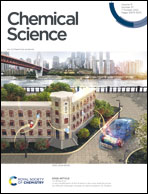A two-dimensional Be2Au monolayer with planar hexacoordinate s-block metal atoms: a superconducting global minimum Dirac material with two perfect Dirac node-loops†
Abstract
Using a starlike Be6Au7− cluster as a building block and following the bottom-up strategy, an intriguing two-dimensional (2D) binary s-block metal Be2Au monolayer with a P6/mmm space group was theoretically designed. Both the Be6Au7− cluster and the 2D monolayer are global minima featuring rule-breaking planar hexacoordinate motifs (anti-van't Hoff/Le Bel arrangement), and their high stabilities are attributed to good electron delocalization and electronic-stabilization-induced steric force. Strikingly, the Be2Au monolayer is a rare Dirac material with two perfect Dirac node-loops in the band structure and is a phonon-mediated superconductor with a critical temperature of 4.0 K. The critical temperature can be enhanced up to 11.0 K by applying compressive strain at only 1.6%. This study not only identifies a new binary s-block metal 2D material, namely Be2Au, which features planar hexacoordination, and a candidate superconducting material for further explorations, but also provides a new strategy to construct 2D materials with novel chemical bonding.



 Please wait while we load your content...
Please wait while we load your content...